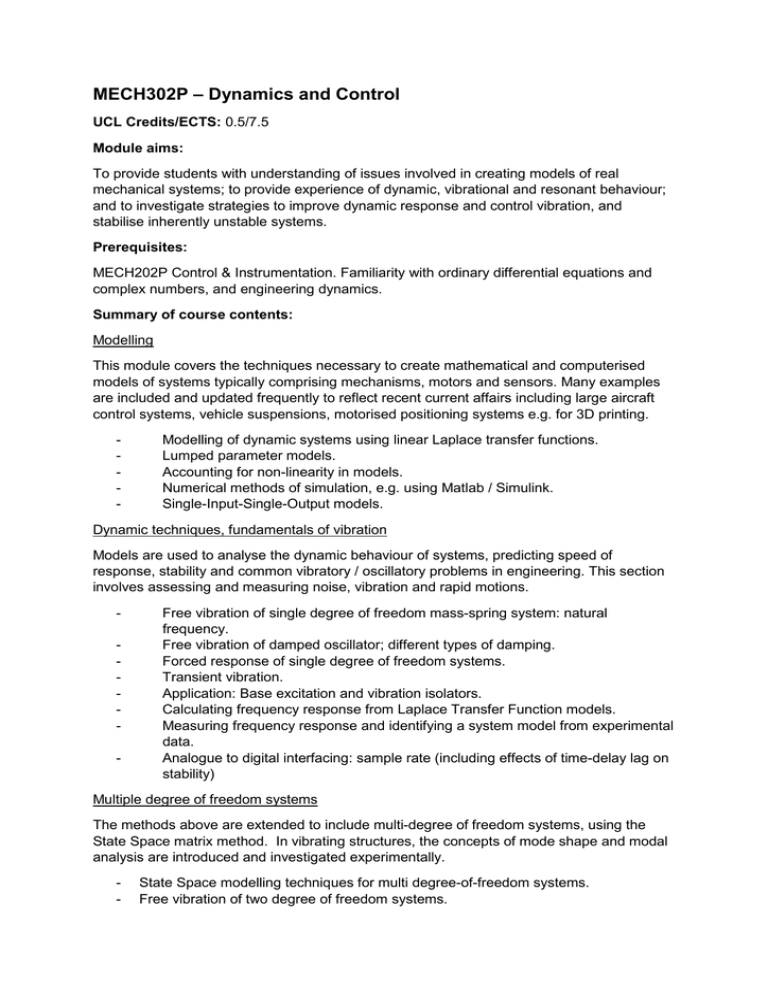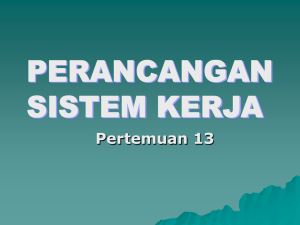MECH302P – Dynamics and Control
advertisement

MECH302P – Dynamics and Control UCL Credits/ECTS: 0.5/7.5 Module aims: To provide students with understanding of issues involved in creating models of real mechanical systems; to provide experience of dynamic, vibrational and resonant behaviour; and to investigate strategies to improve dynamic response and control vibration, and stabilise inherently unstable systems. Prerequisites: MECH202P Control & Instrumentation. Familiarity with ordinary differential equations and complex numbers, and engineering dynamics. Summary of course contents: Modelling This module covers the techniques necessary to create mathematical and computerised models of systems typically comprising mechanisms, motors and sensors. Many examples are included and updated frequently to reflect recent current affairs including large aircraft control systems, vehicle suspensions, motorised positioning systems e.g. for 3D printing. - Modelling of dynamic systems using linear Laplace transfer functions. Lumped parameter models. Accounting for non-linearity in models. Numerical methods of simulation, e.g. using Matlab / Simulink. Single-Input-Single-Output models. Dynamic techniques, fundamentals of vibration Models are used to analyse the dynamic behaviour of systems, predicting speed of response, stability and common vibratory / oscillatory problems in engineering. This section involves assessing and measuring noise, vibration and rapid motions. - Free vibration of single degree of freedom mass-spring system: natural frequency. Free vibration of damped oscillator; different types of damping. Forced response of single degree of freedom systems. Transient vibration. Application: Base excitation and vibration isolators. Calculating frequency response from Laplace Transfer Function models. Measuring frequency response and identifying a system model from experimental data. Analogue to digital interfacing: sample rate (including effects of time-delay lag on stability) Multiple degree of freedom systems The methods above are extended to include multi-degree of freedom systems, using the State Space matrix method. In vibrating structures, the concepts of mode shape and modal analysis are introduced and investigated experimentally. - State Space modelling techniques for multi degree-of-freedom systems. Free vibration of two degree of freedom systems. - Mode shapes and natural frequencies. Multiple degree of freedom systems: modal decomposition. Time harmonic forced vibration with damping. Rayleigh’s method. Lagrange’s equations for free undamped vibration. Continuous systems, string, bars and beams, free and forced vibration. Controller Design The module extends the controller design techniques developed in MECH202P, considering analytical approaches to improving the speed of response and stabilising inherently unstable systems including high performance (autonomous) aircraft. These techniques are investigated in the laboratory which involves balancing an inverted (upside-down) pendulum. - Root-locus methods of controller design (stabilising unstable systems). Frequency response stability analysis (margins of stability). PID & other controller types. Measurement techniques. Control system hardware and practical implementation. Method of delivery: Whole-class lectures will be used to present standard theories of modelling & control, using current examples from a range of industries and research fields to demonstrate their applicability. A laboratory session will give students hands-on experience with sensing and feedback control, demonstrating control of instability using standalone controller hardware. Moodle will be used to provide additional material to support teaching, for formative assessment and for submission of coursework. Matlab software will be used by students for completion of their class assignments. There are no distance learning components. Intended Learning Outcomes: Knowledge & Understanding Create a detailed model of a dynamic system, with multiple degrees of freedom, analyse its response and implement that model in a numerical (computer-based) simulation. To appreciate the difference between a theoretical model and a practical application of a control system and the limitations and constraints for system. To appreciate the role of different mechanical elements of a vibration system and understand the main characteristics of an oscillator as well as importance of vibration treatment in engineering. To understand the concept of mode shape and natural frequency and the link between multidegree of freedom or continuous system and single degree of freedom systems through these concepts. Technical and Transferrable Skills Predict the dynamic performance of system models in the frequency-domain; identifying bandwidth and stability; modifying systems to solve vibration problems. To be able to analyse multi-degree of freedom systems, using modal space to obtain the response. Design interfaces between analogue and digital domains, in order to use a computer/ microcontroller to implement measurement and control of an external device. Perform analytical investigations /simulations of the performance and stability of controlled systems, designing controllers to meet performance specifications including vibration control. Assessment: The course will have the following assessment components: - 75% : Examination (3 hours) 25% : Lab participation and coursework (2000 words max total) To pass this course students must obtain an overall pass mark of 40% for all sections combined. Recommended Reading: Title: Feedback control of dynamic systems Authors: Gene F. Franklin, J. David Powell, Abbas Emami-Naeini. Edition: Seventh edition, Global edition / global edition contributions by Sanjay H.S. Publisher: Boston Massachusetts : Pearson Creation Date: 2015 Identifier: ISBN 9781292068909;ISBN 1292068906 Format: 880 pages : illustrations ; 24 cm. Title: Modern control systems Author: Richard C. Dorf, Robert H. Bishop Edition: 12th ed., International ed. Publisher: Boston ; London : Pearson Creation Date: c2011 Identifier: ISBN 9780131383104 (pbk.);ISBN 0131383108 (pbk.) Format: 1104 p. : ill. ; 24 cm. Title: Mechanical Vibrations Author: Singiresu S. Rao Edition: 4th ed. Publisher: Upper Saddle River, N.J. : Prentice Hall Creation Date: c2011 Identifier: ISBN 0131207687;ISBN 9780131207684 Format: xxvi, 1078 p. : ill., ports. ; 24 cm. Title: Engineering vibration / Daniel J. Inman. Author: D. J. Inman Subjects: Vibration Edition: 4th. ed., International Edition Publisher: Boston : Pearson, [2014] Creation Date: c2014 Identifier: ISBN-10: 0273768441; ISBN-13: 9780273768449 Format: 719 pages : illustrations (black and white) ; 24 cm PLEASE NOTE: This information is given in good faith but accuracy cannot be guaranteed.




